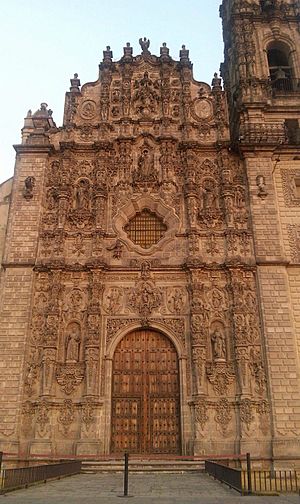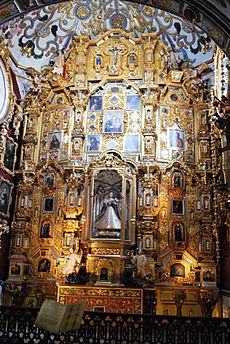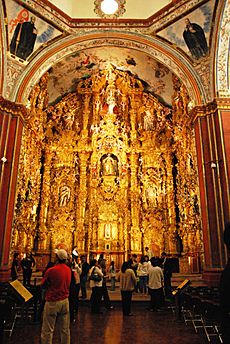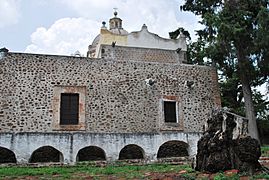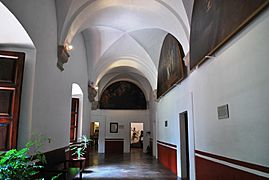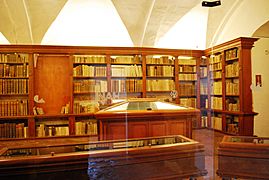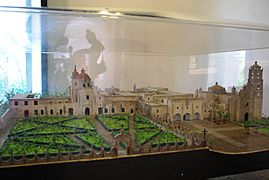Museo Nacional del Virreinato facts for kids
The National Museum of the Viceroyalty (or Museo Nacional del Virreinato in Spanish) is a cool museum located in Tepotzotlán, Mexico State, Mexico. It's part of the Consejo Nacional para la Cultura y las Artes. This amazing place was first built by the Aztecs. Later, the Jesuits started using it in the 1580s.
The complex had three important schools:
- A school to teach local languages to Jesuit missionaries.
- A school for native boys.
- The College of San Francisco Javier, which trained Jesuit priests.
Today, the complex has three main parts:
- The college area, with dorms, a library, a kitchen, and a small chapel.
- The Church of San Francisco Javier.
- The Church of San Pedro Apostol.
The old college and the Church of San Francisco Javier are now the Museo del Virreinato. The college part holds a huge collection of art and everyday items from Mexico's colonial times. The Church of San Francisco Javier has one of Mexico's most important collections of Churrigueresque altarpieces. The Church of San Pedro Apostol is the only part still used for religious services.
Contents
The College of San Francisco Javier: A Place of Learning
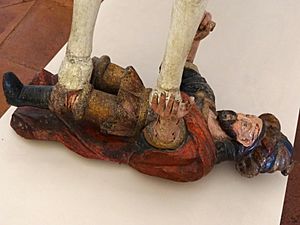
The Jesuits arrived in Mexico in 1572. By the 1580s, other groups like the Franciscans had already taught Christianity to most people in central Mexico. However, the Jesuits found a big need for education. They came to Tepotzotlán in the 1580s and lived in local buildings.
A local leader, Martín Maldonado, was impressed by the Jesuits. They had already started a school to teach priests local languages. Maldonado gave a lot of money to the Jesuits to start a school for Indian boys. This school was called San Martín. Boys learned religion, reading, writing in Spanish, and music there.
In the mid-1580s, the training for Jesuit priests moved from San Pedro y San Pablo College in Mexico City to a new place called the College of San Francisco Javier. These schools made Tepotzotlán one of the most respected learning centers in New Spain.
Growth and Changes at the College
The school complex kept growing during the 1600s. The Church of San Francisco Javier, next to it, started being built in 1670. The school became more and more famous and larger until 1767. That year, the Jesuits were told to leave all Spanish lands. The Spanish Crown then took over all Jesuit properties.
The college was empty for eight years. Then, Archbishop Alonso Nuñez de Haro y Peralta put it under the care of regular priests. He renamed it the Royal College of Instruction, Voluntary Retreat, and Correction for Secular Clergy. This new place not only trained new priests but also served as a retirement home for older or sick priests. It was also a place for priests who had "made some kind of mistake."
The Jesuits came back to former Spanish lands in the mid-1800s. But there weren't enough of them to take over the institution in Mexico, even though it was offered. In 1859, the Reform Laws declared the complex as property of the nation. However, the Church of San Francisco Javier still held Mass.
Because prisons were in bad shape then, people thought about using old monasteries and convents as jails. Even though the complex was given to the State of Mexico in 1871, local people wouldn't let it be used as a jail. Later, Porfirio Díaz also thought about it, but it never happened.
The College During the Mexican Revolution
During the Mexican Revolution, the school was still running. Father Gonzalo Carrasco was the dean. General Coss ordered the priest and his group to leave. There were rumors they were trying to restart a religious order. Knowing Carrasco was a painter, Coss told him to paint a picture of Venustiano Carranza and give up his religious title. Carrasco refused and was sent to prison in Teoloyucan. The students were sent to Mexico City. Soldiers then took over the complex and looted it.
The Jesuits left the college for good in 1914. The church was opened to the public. People kept saying that great treasures were buried on the grounds. This led to searches in 1928, 1931, 1932, and 1934, which damaged the main church. The complex was declared a national monument in 1933. It's one of the few places in Mexico that has been kept completely whole, including its altarpieces and artworks.
Becoming a Museum
In 1961, work began to restore the church and college complex. President Adolfo López Mateos started the project. In 1964, it opened as a museum. Most of the museum's collection came from the old Museum of Religious Art, which was part of the Mexico City Cathedral. Precious metal objects were given by the National Museum of History. A pre-Hispanic blanket was donated by the Museo Nacional de Antropología. Other items came from private donors.
The Museum: A Glimpse into the Past
Most of the complex is now the Museo del Virreinato. It's located in what used to be the College of San Francisco Javier. This museum is considered one of the most impressive in Mexico. This is because of its amazing collection and the beautiful building itself. The college was renovated from 1961 to 1964, led by President Adolfo López Mateos. It opened with much the same look and collection it has today.
The complex has several inner courtyards, like the Aljibes and the Naranjo. It also has a small chapel, a library, dorms, a dining hall, and a kitchen. A wide, arched path at the back leads to huge gardens, over 3 hectares in size. These gardens have sculptures and the original Salta de Agua fountain. This fountain marked the end of the old Chapultepec aqueduct.
What You Can See at the Museum
Much of the museum's collection comes from the old Museum of Religious Art. This museum was once part of the Mexico City Cathedral. These items are spread out among the many rooms of the college complex. You can see pieces made from ivory, wood, and a paste from corn stalks.
Religious clothes from the old museum include special robes like chasubles, dalmatics, stoles, capes, and bags. Items made of precious metals, especially silver, are also on display. These include many types of monstrances, tabernacles, chalices, reliquaries, crosses, censers, candlesticks, and ciboria.
The museum now holds important artworks and other objects from Mexico's colonial period. It has twenty paintings by Cristóbal de Villalpando. You can also see works by Juan Correa, Maerten de Vos, Miguel Cabrera, the Rodríguez Juárez brothers, and José de Ibarra. This is one of the largest collections from the Mexican colonial era. These paintings show different art styles and are mostly about religious topics. Sculptures include works made using "estofado" and "encarnado." These were popular techniques at the time. There are also very realistic sculptures with real hair, glass eyes, and real teeth.
Everyday Life in Colonial Times
You can also see exhibits of non-religious items from the colonial period. These include silverware and other precious metal objects, textiles, and tools. Among the pottery, you'll find pieces made in the Majolica and Talavera styles. There are also Asian pieces that came to Mexico on the Manila galleon.
The museum's furniture collection shows how styles changed over time. It includes tables, chairs, stools, lecterns, and desks. Some have metal and mother-of-pearl designs. Many tools, weapons, and horse-riding items are here. These include irons, harnesses, swords, guns, locks, stirrups, spurs, trunks, chests, helmets, and full suits of armor. There's also a collection of lacquered and inlaid objects from Michoacán and Chiapas from the 1600s.
The museum has beautiful examples of rare feather art. You can also see interesting glass objects, mostly from Spain, France, England, and Germany. The book collection has about 4,000 books. They are kept in the old college library. These books are from the 1500s to the 1800s. They are written in different languages and have various types of bindings.
Museum Services and Events
The museum offers guided tours, a library focused on colonial history, and a bookstore. The Hostería del Convento is a place to stay and eat, located inside the complex. Every year, this hostel hosts "posadas," which are like pre-Christmas plays. They also put on nativity plays. This tradition started again in 1963. These events are filled with songs and fireworks. They also have piñatas and "ponche," a hot, spiced fruit drink.
Church of San Francisco Javier: A Baroque Masterpiece
The Church of San Francisco Javier has a typical Latin cross shape. It has a cupola with a pendentive. The groin vaults inside the church still have their original decorations. In the pendentive, there's a mural from the 1600s. It shows Saint Aloysius Gonzaga with tiger lilies (a symbol of purity), Saint Stanislaus Kostka holding the baby Jesus, Francis of Borgia with a skull, and Ignatius of Loyola with the Jesuit flag. In the 1700s, these paintings were covered by oil paintings of the Four Evangelists. They were moved to the ante-choir in the 1960s.
The Church Facade
The front of the Church of San Francisco Javier was built between 1760 and 1762. It's made of grey stone and covered the original facade from the 1600s. This facade is thought to be designed by architect Ildefonso Iniesta Bejarano. The facade shows the same themes you'll see in the altarpieces inside. The most important image is of the Virgin Mary as the main protector of the Jesuits. At the very top is an image of the Archangel Michael.
The decorations on the facade continue up the bell tower, which is from the 1700s. You can clearly see the "estipite" (an upside-down pyramid-like column) used here. The tower is topped with an iron cross. This facade is considered the most important example of the Churriguerisque style in Mexico.
The Atrium and Altarpieces
The large open area in front of the museum complex is called the Plaza de la Cruz. It has a stone cross carved with scenes from the Passion of Christ.
The Church of San Francisco Javier is no longer used for religious services. It's now part of the museum. This church has one of the most important collections of Churrigueresque altarpieces in Mexico. These altarpieces feature the Baroque estipite column. They were made in the 1700s by Higinio Chavez. All of them are made of white cedar wood and covered in gold leaf.
In the main altarpiece, there's a painting of God, the Father at the very top, done by Miguel Cabrera. Below that is an image of the Immaculate Conception with Saint Joachim and Saint Anne on the sides. Underneath this is an image of John the Baptist with Saint Joseph next to him. The altar also includes images of two martyrs who died in Japan. In the center of the altarpiece is the image of Saint Francis Xavier, a co-founder of the Company of Jesus. He is shown with a flaming heart on his chest, which symbolizes divine love.
The main altar and the side altars are connected by their themes. The altars on the presbytery side are dedicated to two very important Jesuit saints (Saints Ignatius of Loyola and Saint Joseph). The altars on the other side are dedicated to members of the Third Order of the Company of Jesus. These include Francis of Borgia, shown with a crowned skull, Aloysius Gonzaga, and Stanislav of Kotska. Another altarpiece is dedicated to the Virgin of Guadalupe and was finished in 1756. This altar shows the Virgin as she appeared to Juan Diego. It also features other saints connected to harvests, like Saint Barbara.
Chapels and Relics
In the second part of the church's main area, there's the Chapel of the Virgin of Loreto. It has an entrance that looks like a copy of the house of Loreto. At the back of the church is the Alcove of the Virgin and the Chapel of the Relic of Saint Joseph. The House of Loreto is traditionally believed to be the home of the Virgin Mary. Behind it, there's a small alcove dedicated to the Virgin of Loreto. Near here is a very small room dedicated to a relic believed to be from Saint Joseph. Next to this are the presbytery and the sacristy, which is full of oil paintings. The Church of San Francisco Javier, the Loreto Chapel, and the Alcove of the Virgin of Loreto are considered works of art themselves.
Church of San Pedro Apostol: Still a Place of Worship
To the left of the Church of San Francisco Javier is the Church of San Pedro Apostol. Its main entrance faces the atrium. It's built in the Neoclassic style. This is the only part of the museum complex that is still used for religious services and functions.
Images for kids
See also
 In Spanish: Museo Nacional del Virreinato para niños
In Spanish: Museo Nacional del Virreinato para niños
- List of Jesuit sites


